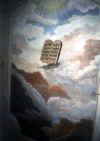
From Ruth Ellen Gruber
ROME (JTA) -- Ivan Ceresnjes has documented
synagogues all over the former Yugoslavia, but he's never come across
anything like the strange painting in the former synagogue in Apatin, a
small town in Serbia near the Hungarian border.
"It is a kind of mystery," Ceresnjes, who
works with the Center for Jewish Art at Hebrew University, told JTA from
Jerusalem. "I am still searching for some reasonable explanation."
The painting in question is a neo-baroque mural on
the ceiling of the synagogue, a simple village structure built in 1885 for a
Neolog congregation -- the Hungarian version of Reform Judaism.
It shows a sky filled with dramatic banks of clouds
framing a depiction of the Ten Commandments -- but the Hebrew lettering is
written backwards, in mirror image.
Ceresnjes, an architect who was president of the Jewish community in Bosnia
before making aliyah in 1996, called the mural unique.
No
comparable example exists in either that part of Serbia or neighboring
Hungary, he said, and no-one knows why such an image was painted.
"It is the message of the painting that should
be decoded," he said. "Three Rabbis, all of them educated in
Budapest, officiated consecutively in that Neolog congregation, and none of
them seems to have been disturbed by the picture's central motif, a mirror
image of the Luhot positioned in such a way that we can assume that
it was done deliberately."
Ceresnjes, who has carried out extensive
documentation of synagogues and Jewish cemeteries in all the countries that
made up the former Yugoslavia, said nothing was known about the architect of
the synagogue, the artist who painted the ceiling or the circumstances under
which it was created.
However, he said, the artist was probably local and
presumably not Jewish, as there is no record of any Jewish painter in the
area in that time. In this case, Ceresnjes said, he would have been guided
by someone, presumably the rabbi of the community.
Nonetheless, Ceresnjes said, "I do not exclude
the possibility that the painter came from Hungary - there are a lot of
Church paintings of the same style from that period, but I am afraid that it
would be very difficult to trace the name."
Only about 60 Jews lived in Apatin before World War
II, and the community was annihilated in the Shoah. In the 1950s, the
synagogue was sold to the Baptist church.
Ceresnjes fears that there are plans to sell the
building again and turn it into a workshop, and he has warned that steps
should be taken to save the painting.
"The painting is unique by all means, very
important for preservation and protection," he said. "Further
neglect or allowing it to disappear or be destroyed would be an irreparable
loss for the Jewish cultural and religious community as a whole."
Ruth Ellen Gruber
author of:
Virtually Jewish: Reinventing
Jewish Culture in Europe
University of California Press
Mikve
crkva